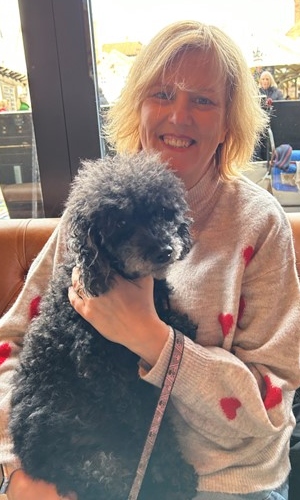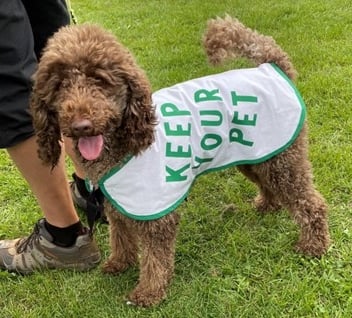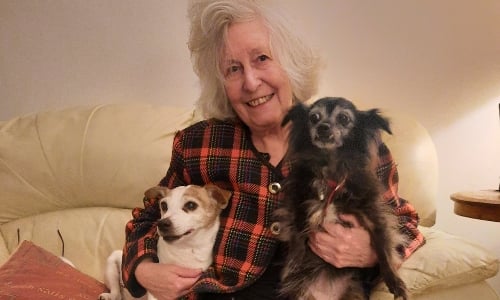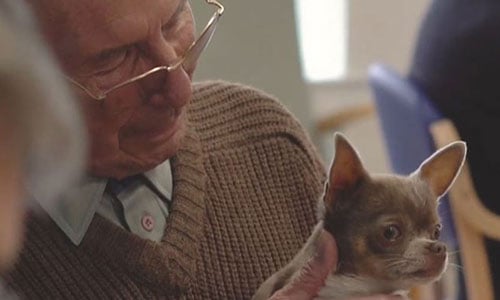Animals can have a profound effect on our health and wellbeing.
Listening to birdsong has been shown to lower blood pressure, walking a dog helps us stay active, and connecting with four-legged friends has even been used as a form of dementia support.
But for many pet owners, the biggest benefit of sharing life with an animal is the companionship – and losing that can be devastating. Bev, who runs the Keep Your Pet service at Age UK York, understands this better than most. The proud owner of three dogs herself, in her 10 years working for Age UK York, Bev has helped hundreds of older people keep their furry friends while dealing with difficult changes to their personal circumstances.
“For a lot of older people who are suffering from loneliness and isolation, their four-legged companion is their one reason to get up in the morning,” explains Bev.

Peace of mind
The Keep Your Pet programme began in 2012, when two local residents identified that older pet owners needed support, so asked Age UK York to find a solution. “Luckily, the CEO of Age UK York at the time was a huge dog lover,” laughs Bev. “We haven’t looked back since.”
Although most animals helped by the service are dogs, over the years Keep Your Pet’s volunteers have been known to look after hamsters, budgies, and even a bearded dragon. The programme offers a range of short-term and longer-term support services, catered to whatever the pet owner needs help with.
“One of the main things we do is to look after animals whose owners have had to go into hospital,” says Bev. “We find that cats prefer to stay in their own home, so we’ll go in and visit them, but we foster dogs. We’ll then continue to walk the dog during the owner’s recovery. For older people who don’t drive anymore, we’ll also take animals to the vets or pick up medication if needed.
“Often, we’re contacted by people who don’t need support yet, but register just in case – especially if they don’t have any family nearby. It’s a bit of comfort knowing that someone’s there to step in if needed.”

For a lot of older people who are suffering from loneliness and isolation, their four-legged companion is their one reason to get up in the morning.
Knowing that her cat Flossie would be looked after has given Mary peace of mind during her hospital visits. “My recent admissions into hospital have proven challenging to make plans for because they keep expecting things to take longer than they do, or they keep changing the date,” says Mary. “It’s reassuring to know Flossie can be taken care of. I’d been so afraid I would need to give her up because of the unpredictability of my health.”
With some swift adaptations to keep both volunteers and pet owners safe, Keep Your Pet even continued to operate during the pandemic – “those dogs still needed to get out and walk!” – and Bev has found that the service is now busier than ever. “At any one time, we could be walking up to 35 animals a week, and we’ve got nearly 100 volunteers ready to help,” she says. “We don’t struggle to recruit them – when you get older people and animals together, it’s quite a big draw.”
Keeping the connection
“Sometimes, people ask us questions like, ‘If you’re from Age UK, then why are you helping animals?’” Bev reveals. “But really, we’re not so much there to help the animals as to help the older person. The older person is our priority, and their priority is their pet.”
For Bev, this ethos means that the needs of each older person who uses Keep Your Pet are being addressed just as much as those of the animal. “At the moment, one of our volunteers is doing a regular accompanied dog walk with a lady in her 80s,” Bev tells us. “This lady recently lost her husband, who used to walk the dog, and the dog is too strong for the lady to walk by herself. She doesn’t want to give up her one companion now, so our volunteer walks the dog with the lady accompanying, offering a steady arm. They can chat as they stroll, so it’s a little bit like befriending.
“Another of our volunteers has a similar situation with a man who has dementia. He still wanted to get outside and walk his dog, but was finding he was getting lost – so now a volunteer goes with him.

The older person is our priority, and their priority is their pet.
“Over time, the dog walkers build up a real bond with the older people they’re helping. Our volunteers are trained in all aspects of Age UK York services, so if they go to pick up an animal and discover that the owner is really struggling with doing their shopping, for example, the volunteer can identify that extra need and we can send someone out to meet it. It’s a way for us to keep track of the wellbeing of the older people we’re helping.”

Even when keeping a pet is no longer feasible, Bev’s team can still be there to bring happiness with some four-legged friends. “If an owner goes into a care home and it isn’t pet-friendly, we’ll make sure the animal is rehomed,” Bev explains. “But sometimes, the care home has let us take the pet in for visits, if that’s something the former owner would like – because for some it can be upsetting, but for others it can be very comforting.
“We also run two dog cafés a month, so that people who can’t have an animal anymore can come and socialise with people and the dogs they bring along. The connection is really great for getting people out and about.”
Leading the way
Considering the service is going from strength to strength, what does Bev hope the future holds for Keep Your Pet? “As far as I’m aware, we’re the only local Age UK who runs a Keep Your Pet service,” says Bev, “and there’s only a handful of organisations outside of Age UK – like The Cinnamon Trust – who do what we do. There’s a huge gap.
“We get requests from all over the country for help, so it would be nice to be able to refer people who get in touch to Keep Your Pet services in other parts of the UK. We know that being able to give owners peace of mind makes such a difference.”
Owning a pet in later life
Having a pet can be hugely rewarding, but there are some considerations to bear in mind.






